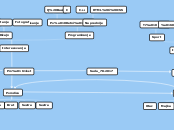Stefan Marinković
Marine life, sea life or ocean life, is represented by the plants, animals and other organisms that live in the saltwater of the sea or ocean, or the brackish water of coastal estuaries.
At a fundamental level, marine life affects the nature of the planet. Marine organisms produce oxygen and sequester carbon.
Veštine koje posedujem
Fish are limbless cold-blooded vertebrate animal with gills and fins living wholly in water.
Programiranje
Enumerate at least 10 of the most popular fish.
Programski jezik C++
Programski jezik C
Rad na recepciji hotela
Strani jezici
Rays are the largest group of cartilaginous fishes, with well over 600 species in 26 families.
Rays look like bats in the water, and this is probably why they are called batoids. Rays use their pectoral fins to 'fly' through the water. Though a bony fish takes in water with its mouth, rays do not because they live at the bottom of the ocean.
Name a few of the most known species.
Nemački jezik
Engleski jezik
Poznavanje rada na računaru
Species in the shark subclass have skeletons made from cartilage, not bone, and have five to seven gill slits on each side of their heads (most other fish have only one gill slit on each side), which they use to filter oxygen from the water.
Enumerate a few of the most known species of sharks:
Html
Excel
Power Point
Word
Lični podaci
A coral reef is an underwater ecosystem characterized by reef-building corals. Reefs are formed of colonies of coral polyps held together by calcium carbonate. Most coral reefs are built from stony corals, whose polyps cluster in groups.
The 3 main types of reef are: atoll, barrier reefs, fringing reefs.
Write down their characteristics as well as the importance of the reefs
Spreman za dalje usavršavanje
Coral reefs are important for many different reasons aside from supposedly containing the most diverse ecosystems on the planet.
Perspektivan i mlad
- Where are fringing reefs found?
- How is it formed?
- What animals live in fringing reefs?
Sposoban za individualni kao i za timski rad
- What is a barrier reef?
- How is it formed?
- Where are barrier reefs located?
Vredan, odgovoran, voljan da uči u cilju napredovanja na poslu
- How does an atoll form?
- Where are atolls found?
- Can people live on an atoll?
Radno iskustvo (Sertifikati)
Seabirds are birds that are adapted to life within the marine environment. While seabirds vary greatly in lifestyle, behavior, and physiology, they often exhibit striking convergent evolution, as the same environmental problems and feeding niches have resulted in similar adaptations.
Name a few of bird species who live at sea or at the seaside:
Sertifikat o odrađenoj stručnoj praksi
Hotel "Livade" Čačak
Hotel "Kole" Čačak
Hotel "Beograd" Čačak
Obrazovanje
Marine mammals are aquatic mammals that rely on the ocean and other marine ecosystems for their existence.
They include animals such as seals, whales, manatees, sea otters, and polar bears. They are an informal group, unified only by their reliance on marine environments for feeding.
Fakultet tehničkih nauka Čačak
- Why are they called sea cows?
- Where do they live?
- How long can they stay underwater?
- Can manatees live on land?
- Do manatees sleep underwater?
Informacione tehnologije
Prehrambeno-ugostiteljska škola Čačak
- How are seals and sea lions alike?
- Are seals or sea lions aggressive?
- Why are sea lions called sea lions?
- What is a group of seals called?
Turistički tehničar
OŠ "Branislav Petrović" Slatina
- How big are whales?
- What do whales eat?
- How are whales different from fish?
- Where do whales live in the world?
- What are whales known for?
Osnovni podaci
Currently, of the approximately 12,000 extant reptile species and subspecies, only about 100 are classed as marine reptiles: extant marine reptiles include marine iguanas, sea snakes, sea turtles and saltwater crocodiles.
E-mail
The marine iguana, also known as the sea iguana is a species of iguana found only on the Galápagos Islands that has the ability, unique among modern lizards, to forage in the sea, making it a marine reptile.
Add important facts about marine iguanas. For e.g. how long can a marine iguana stay underwater or how long do they live, etc.
ek.stefanmarinkovic@gmail.com
Telefon
Crocodilians may be found swimming out at sea, but they can't live out there in the way that a marine turtle can.
Research, then write down what you know about them. For e.g, their lifespan, their weight, where you can spot them. etc
0629776197
Adresa
Sea snakes, or coral reef snakes, are a subfamily of venomous elapid snakes, that inhabit marine environments for most or all of their lives. Most are extensively adapted to a fully aquatic life and are unable to move on land.
Research, then write down facts about sea snakes, for e.g. how fast they swim, what do they eat or how long they live, etc.
Ulica Cara Lazara 54
Datum rodjenja
10.08.2001
Mesto rođenja
Write down some interesting facts about sea turtles, like how long they live or how long can they dive, etc.
Kraljevo, Republika Srbija









